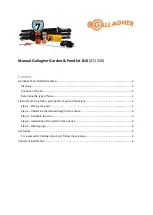
Biacore T100 Software Handbook BR-1006-48 Edition AE
115
Evaluation software – general features 6
6.7
Solvent correction
6.7.1
Background
Solvent correction adjusts reference-subtracted responses for small artefacts
that can be introduced by variations in the bulk refractive index between
samples. The correction is only relevant when variations in the bulk refractive
index are of the same order of magnitude as the response: this situation arises
commonly in work with small organic analytes that give intrinsically low
response values and that often require organic solvents such as dimethyl
sulfoxide (DMSO) to maintain solubility.
The need for solvent correction arises because subtraction of the reference
response does not exactly eliminate the contribution of the bulk solution to the
measured response. Bulk solution is excluded from the volume occupied by
ligand on the active surface, so that the bulk contribution to the response on the
active surface is slightly smaller than that on the reference surface (Figure 6-1).
Figure 6-1.
Bulk solution is excluded from the volume occupied by ligand molecules on the
ligand surface, so the bulk contribution to the relative response is smaller than on the
reference surface.
As long as the refractive index of the samples is constant, this excluded volume
effect introduces a constant error in reference subtraction which may be
ignored for practical purposes. However, if the refractive index of the samples
varies, the magnitude of the excluded volume effect will also vary.
Organic solvents like DMSO often give a high bulk response (addition of 1%
DMSO gives a bulk response of about 1200 RU), so that small variations in the
DMSO content lead to significant variations in the bulk response between
samples. Such variations are unavoidable in the preparation of diverse samples
such as drug candidates for screening applications. The solvent correction
procedure corrects for the variations arising from the excluded volume effect in
these cases.
Response on
reference surface
Response on
ligand surface
Excluded volume effect
Ligand surface
Reference surface
Summary of Contents for Biacore T100
Page 1: ...GE Healthcare Biacore T100 Software Handbook ...
Page 2: ......
Page 8: ...8 Biacore T100 Software Handbook BR 1006 48 Edition AE ...
Page 13: ...Biacore T100 Software Handbook BR 1006 48 Edition AE 13 Control Software ...
Page 14: ...14 Biacore T100 Software Handbook BR 1006 48 Edition AE ...
Page 30: ...3 Manual run 3 4 Ending a manual run 30 Biacore T100 Software Handbook BR 1006 48 Edition AE ...
Page 103: ...Biacore T100 Software Handbook BR 1006 48 Edition AE 103 Evaluation Software ...
Page 104: ...104 Biacore T100 Software Handbook BR 1006 48 Edition AE ...
Page 207: ...Biacore T100 Software Handbook BR 1006 48 Edition AE 207 Appendices ...
Page 208: ...208 Biacore T100 Software Handbook BR 1006 48 Edition AE ...
Page 236: ...236 Biacore T100 Software Handbook BR 1006 48 Edition AE ...
Page 237: ......
















































